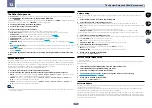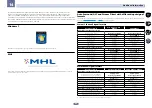
102
13
FAQ
Symptom
Remedy
No sound from subwoofer.
Check that the subwoofer is connected properly, switched on and the volume turned up.
If your subwoofer has a sleep function, make sure it is switched off.
Make sure that the Subwoofer setting is
YES
or
PLUS
(see
Speaker Setting
on
page 93
).
The crossover frequency may be set too low; try setting it higher to match the characteris-
tics of your other speakers (see
Speaker Setting
on
page 93
).
If there is very little low frequency information in the source material, change your
speaker settings to Front:
SMALL
/ Subwoofer:
YES
, or Front:
LARGE
/ Subwoofer:
PLUS
(see
Speaker Setting
on
page 93
).
Check that the
LFE
channel is not set to
OFF
, or to a very quiet setting (see
Setting the
Audio options
on
page 70
).
Check the speaker level settings (see
Channel Level
on
page 94
).
No sound from the speakers.
Check the
AMP
setting. Set it to
ON
when you want to output sound from all the speakers
(
Setting the Audio options
on
page 70
).
No sound from one speaker.
Check the speaker connection (see
Connecting the speakers
on
page 22
).
Check the speaker level settings (see
Channel Level
on
page 94
).
Check that the speaker hasn’t been set to
NO
(see
Speaker Setting
on
page 93
).
The channel may not be recorded in the source. By using one of the advanced effect
listening modes, you may be able to create the missing channel (see
Enjoying various
types of playback using the listening modes
on
page 55
).
Sound is produced from analog
components, but not from digital
ones (DVD, LD, CD, etc.).
Check that the input signal type is set to
DIGITAL
(see
Choosing the input signal
on
page
57
).
Make sure that the digital input is assigned correctly for the input jack the component is
connected to (see
The Input Setup menu
on
page 44
).
Check the digital output settings on the source component.
If the source component has a digital volume control, make sure this is not turned down.
No sound is output or a noise is out-
put when Dolby Digital/DTS software
is played back.
Check that your BD or DVD player is compatible with Dolby Digital/DTS discs.
Check the digital output settings or the HDMI audio output settings of your BD or DVD
player. Make sure that the DTS signal output is set to On.
If the source component has a digital volume control, make sure this is not turned down.
No sound when using the
Home Menu
.
If the HDMI input function is selected, sound is muted until exiting the
Home Menu
.
Other audio problems
Symptom
Remedy
Speaker switching sound (clicking
sound) is heard from receiver during
playback.
Depending on the listening mode, the front height (or front wide) and surround back
speakers may switch automatically in function of changes in the input audio. A speaker
switching sound (clicking sound) will be heard from the receiver at this time. If this sound
bothers you, we recommend to change the speaker terminal option (see
Switching the
speaker terminals
on
page 74
).
Broadcast stations cannot be
selected automatically, or there is
considerable noise in radio broad-
casts.
Fully extend the FM wire antenna, adjust the position for best reception and secure to a
wall, etc.
Use an outdoor antenna for better reception (see
page 34
).
Adjust the position and direction of the AM antenna.
Noise may be caused by interference from other equipment, such as a fluorescent light,
motor, etc. Switch off or move the other equipment, or move the AM antenna.
Symptom
Remedy
Noise is output when scanning a
DTS CD.
This is not a malfunction of the receiver. The scan function of your player alters the digital
information, making it unreadable, resulting in noise being output. Lower the volume
when scanning.
When playing a DTS format LD there
is audible noise on the soundtrack.
Make sure that the input signal type is set to
DIGITAL
(see
Choosing the input signal
on
page 57
).
Can’t record audio.
You can only make a digital recording from a digital source, and an analog recording
from an analog source.
For digital sources, make sure that what you’re recording isn’t copy protected.
Subwoofer output is very low.
To route more signal to the subwoofer, set it to
PLUS
or set the front speakers to
SMALL
(see
Speaker Setting
on
page 93
).
Everything seems to be set up cor-
rectly, but the playback sound is odd.
The speakers may be out of phase. Check that the positive/negative speaker terminals on
the receiver are matched with the corresponding terminals on the speakers (see
Connect-
ing the speakers
on
page 22
).
The Phase Control feature doesn’t
seem to have an audible effect.
If applicable, check that the lowpass filter switch on your subwoofer is off, or the lowpass
cutoff is set to the highest frequency setting. If there is a PHASE setting on your sub-
woofer, set it to 0º (or depending on the subwoofer, the setting where you think it has the
best overall effect on the sound).
Make sure the speaker distance setting is correct for all speakers (see
Speaker Distance
on
page 94
).
Full Band Phase Control cannot be
selected.
Perform Full Auto MCACC measurements (see
Automatically conducting optimum sound
tuning (Full Auto MCACC)
on
page 42
). Full Band Phase Control automatically turns on
once measurements are completed.
Noise or hum can be heard even
when there is no sound being input.
Check that personal computers or other digital components connected to the same
power source are not causing interference.
Can’t select some Input functions by
the
INPUT SELECTOR
on the front
panel or the
INPUT SELECT
button
on the remote control.
Check the
Input Skip
settings in the
Input Setup
menu (see
The Input Setup menu
on
page 44
).
Check the
HDMI Input
assignment in the
Input Setup
menu then try
OFF
(see
The Input
Setup menu
on
page 44
).
There seems to be a time lag
between the speakers and the output
of the subwoofer.
See
Automatically conducting optimum sound tuning (Full Auto MCACC)
on
page 42
to
set up your system again using MCACC (this will automatically compensate for a delay in
the subwoofer output).
The maximum volume available
(shown in the front panel display) is
lower than the
+12dB
maximum.
Check that the
Volume Limit
is set to
OFF
(see
Volume Setup
on
page 97
).
The channel level setting may be over
0.0dB
.
Certain listening modes or
HOME MENU
items cannot be
selected.
When
Operation Mode
is set to
Basic
, the Pioneer-recommended settings are made and
not all of the functions can be used. To use all of the functions without restrictions, set
Operation Mode
to
Expert
(see
Operation Mode Setup
on
page 45
).
















































